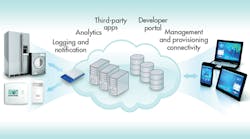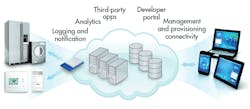This file type includes high-resolution graphics and schematics when applicable.
The Internet of Things (IoT) isn’t new technology, but rather the application of well-known technologies to new situations and use cases. For that reason, it would be easy to assume that creating a connected product isn’t so difficult. That assumption would be very, very wrong.
The IoT is actually a system of systems connected by networks (see figure). IoT implementations require sophisticated coordination of communications and operation across all of those systems: sensor-enabled connected products, various clouds and networks, and the mobile or web applications used to control the connected products or monitor their performance. What’s more, IoT products themselves typically lack anything approximating the compute, memory, or storage capabilities of the computers and mobile devices currently connected to the Internet.
Because of these challenges, manufacturers designing and building products for the IoT are almost always best served by working with a comprehensive IoT platform. The right IoT platform technology will be specialized to handle the functionality needed by any IoT product, freeing manufacturers to focus on their core competences and building the best connected versions of their offerings.
Ask the Right Questions
Finding the answers to a few key questions can help you choose IoT platform technology to speed and improve the creation of your connected products. Here are some questions to consider—and what to look for in the answers:
Question #1: What’s your IoT security strategy?
Not surprisingly, security tops nearly everyone’s list of major IoT concerns. IoT platform technology must have enterprise-grade security baked into the full IoT spectrum, from connected product to cloud to mobile or web app. Listen for end-to-end, integrated, standards-based technology encompassing:
• AAA security (Authentication. Authorization, Accounting)
• Device-to-cloud network security
• User app-to-wireless network security
• Cloud security
• Device security, including authentication and up-to-date certificates
• Application authentication
• Data encryption
• Data protection at rest, in transit, and in the cloud
• Secure session initiation
• Concrete plans for updating security, including via over-the-air (OTA) communications
Question #2: How do you handle mobile/web application development?
Too many manufacturers leave application development for the end of their IoT process, which is a big mistake. Because the mobile or web app is the driver of the IoT product’s user experience, it will be how customers judge the success or failure of connected products.
IoT platform providers needn’t be full-scale mobile-app developers, too, but ideally an IoT platform will include tools for speeding and integrating application development with the rest of the IoT technology. It will also have an ecosystem of dedicated application developers that can do the final customization and personalization of your control applications.
In addition, look for IoT platform providers that offer role-based access-control (RBAC) capabilities. This allows connected products to be controlled differently based on an individual’s “role”—within an organization or a household—or based on conditions such as time or location.
Question #3: How flexible is your IoT platform with respect to future unknowns?
Technology in general, and the IoT in particular, hurtles ahead at a breakneck pace. Outpacing obsolescence presents a constant challenge.
IoT platforms must be built with flexibility and future-proofing in mind. No matter what features, protocols, or new technologies emerge or are required in the future, an IoT platform should ensure that your connected products don’t get stuck in technology dead-ends.
An agile IoT platform will be built upon open standards—and its provider will have a proven commitment to keep pace with IoT technologies, protocols, and standards as they morph and evolve.
Question #4: What happens when we want to drastically increase our number of connected products?
Implementing a handful of connected products is challenging enough. When the number of connected products scales to the many thousands or millions—headed toward industry predictions of billions of IoT devices in the next five years or so—the situation gets far more complex.
Scalability in the IoT means the ability to scale not only in the number of devices, but at the cloud, software-application, data, security, reliability, latency, user-experience, and even the support levels.
Question #5: How much time will it take to launch a connected product?
An IoT platform provider should be able to speed time to market for your connected products, but be wary of unrealistic time estimates. Don’t expect schedules for connected products to mirror your experience with traditional products. Factors such as firmware development, wireless radios, cloud operations, mobile/web application development, and end-to-end security must be engineered into IoT products.
Here’s a good rule of thumb from an ideal IoT platform provider: A single connected product might take nine months to a year to get to market; products that use gateways might require 12 to 18 months.
In addition, make sure to allow sufficient time for field testing. The leading IoT platform providers recommend a minimum of three months of field testing for simple products, and up to six months for more complex IoT solutions. Rigorous field testing is the only way to uncover bugs, security holes, or poor handoffs along the device-to-cloud-to-app spectrum—and to remove the problems before the product launches.
Question #6: How will our connected products interoperate with other connected products, as well as various cloud infrastructures and third-party services?
For IoT products to reach their full potential, they must connect and interoperate with the broadest possible range of other connected products from a variety of manufacturers, as well as services like energy management, weather forecasting, environmental conditions, and traffic reports.
As with things like scalability and security, interoperability is something that has to be designed in from the outset—it can’t be “added on” later. When evaluating IoT platforms, look for those that have clear, well-formulated answers to how your connected products will interoperate with other devices and services, plus whatever might emerge in the future.
Question #7: What happens to a connected device’s operation if the power or network connection fails?
Schedules and other instructions can’t be lost when the internet connection or power goes down. An IoT platform needs to be designed so that basic operations “take care of themselves” even without network access. For instance, end users should be confident that their door locks won’t fail and let anyone in (or keep authorized people out), and that they can still turn their lights on and off if there’s a network outage.
IoT platforms need approaches such as LAN mode to ensure continued operations of connected products, even when there’s no internet connection.
Question #8: Who owns the data generated by our connected products?
The answer you should get from an IoT provider is simple: You should own the data generated by your products. Make sure that an IoT platform provider doesn’t retain ownership to any aspect of your data. Otherwise, the greatest value of the IoT, which lies in leveraging the data generated about real-world product operations and usage, will remain hidden from you as the manufacturer.
Still More Questions
Of course, many other questions are worth asking an IoT solution provider than those outlined here—questions about latency and responsiveness, customer support, what to do with the data generated by connected products, and more.
Also pay attention to the questions that potential IoT platform providers ask you. They should be finding out about your use cases, your expectations, your budget, and your overall IoT strategy.
The IoT is a big deal. Done haphazardly or without proper planning, it can be a disastrous money and time sink. Done well, however, it can lead to increased market share, new revenue streams, and even an entirely different approach to designing and building products. Asking the right questions from the beginning will help determine which route you take.
Adrian Caceres is passionate about connected products and has made connectivity the core of his professional career. As co-founder of Ayla Networks, he’s helping to shape the future of the Internet of Things (IoT). Adrian came from Amazon’s Lab126, where he was the technical lead for the Kindle wireless software team and helped launch the first Kindle with Wi-Fi. He holds a B.S. in electrical engineering from Worcester Polytechnic Institute.




